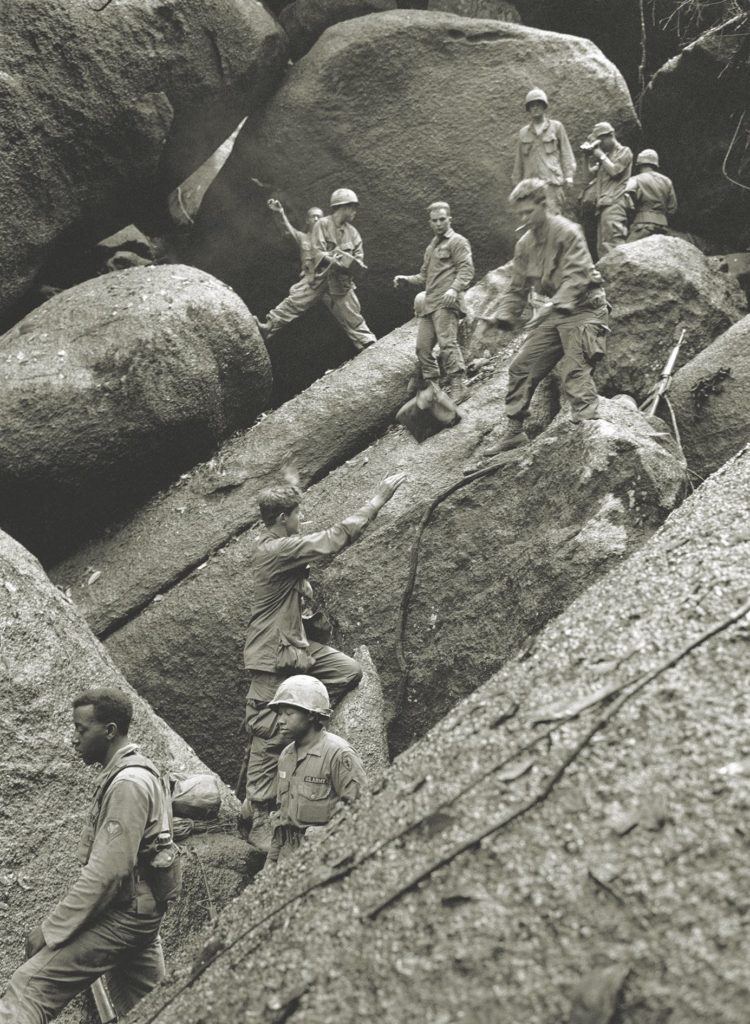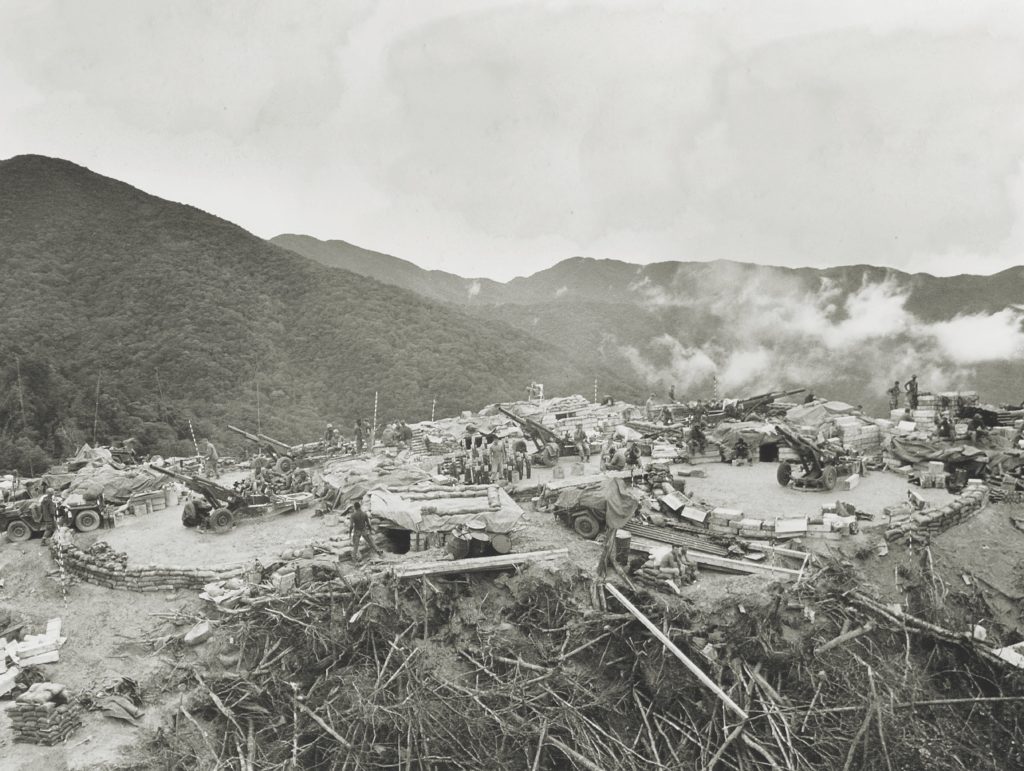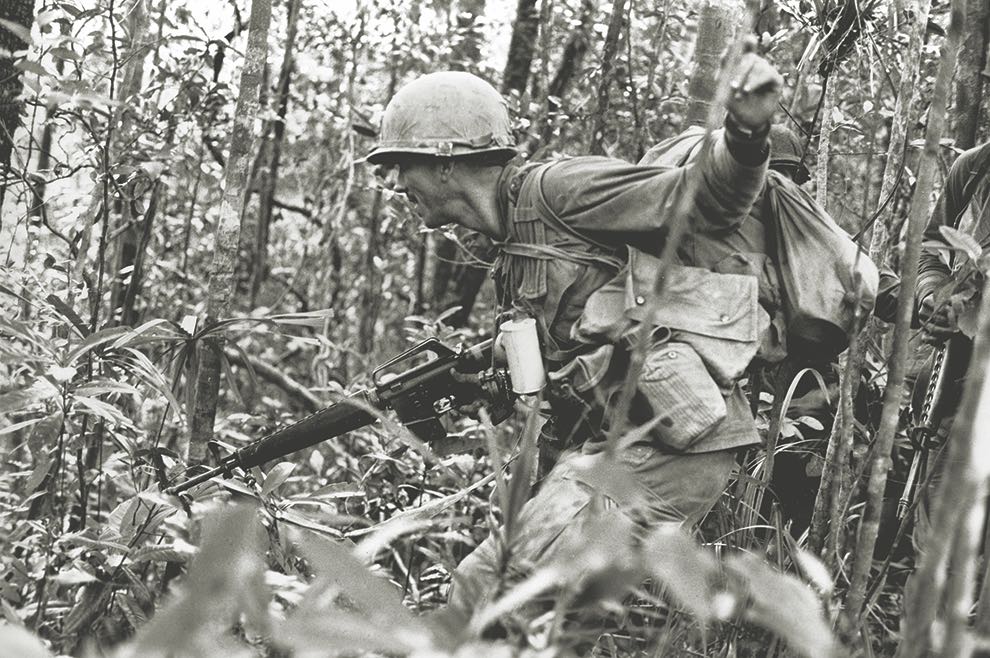The experiences of U.S. infantrymen in Vietnam are told in many ways: through personal memoirs, media accounts, oral histories— and the government’s own reports. Historian Chris McNab mined those reports to produce The U.S. Army Infantryman Vietnam Pocket Manual, which reprints declassified primary documents such as field manuals, weapons manuals, intelligence analyses and after-action reports, including those with “lessons learned” sections. This article features two lessons-learned sections, with introductions by McNab.
The Vietnam War, and the diligent efforts of archivists, has left us with a vast archive of U.S. Army infantry after-action reports, many of which conclude with a “lessons learned” section that summarized the tactical knowledge acquired from the particular operation. The following report was part of a broader compilation of these reports. The explanatory document that introduces the report explains that it “is the first of the 1968 special series of numbered Operations Reports—Lessons Learned. It contains a summary of selected items based on information reported in Operational Reports—Lessons Learned and Combat After Action reports submitted during 1967.”
Information collected in documents such as these would be distributed to front-line units and training formations back in the States, hopefully to improve the survivability of those new to Vietnam operations. In the extracts below, there are interesting discussions about various tactical challenges, particularly those relating to winkling out the enemy from rocky cave complexes (common in mountainous areas).
From “Operations Report—Lessons Learned 1-68: Summary of Lessons” (1968)
SECTION 1: MANEUVER TACTICS AND TECHNIQUES
1. ITEM: Pursuit, battlefield sweep and evacuation of the wounded. (670698)
DISCUSSION: The 4th Infantry Division reports that there is a built-in conflict as to what action should be taken immediately upon the enemy attempting to withdraw in the dense jungle near the Cambodian Border. The ideal situation would be to have a landing zone in the immediate proximity of the contact area through which reinforcements could be inserted to initiate an aggressive exploitation or pursuit. Simultaneously, the US unit in contact should evacuate its wounded and dead and initiate an immediate sweep of the battlefield. However, in dense jungle landing zones are not readily available in the vast majority of cases. As soon as the situation permits, and in the absence of a landing zone, the US unit must cut a landing zone out of the jungle foliage to evacuate the wounded. The normal time required to cut such a landing zone is about 15 hours, but may often extend to 24 hours and, on occasion, may exceed 36 hours. During this period, the enemy is making a maximum effort to evacuate his wounded, documents, weapons and other items of equipment from the battle area. In many cases, he is able to physically remove his dead before a sweep of the battlefield can be accomplished.
OBSERVATION: Each situation must be analyzed carefully to determine the sequence of
the actions to be taken. If at all possible, reinforcements should be inserted to pursue the enemy and to otherwise exploit the situation. Moreover, immediate action must be taken either by the US unit in contact or by the reinforcing unit, as the case may be, to conduct an immediate sweep of the battlefield. Obviously, the seriously wounded must be evacuated from the battlefield by the fastest method in order to prevent further loss
of lives. To accomplish all of these things in the proper order or simultaneously requires careful judgment and coordination by the commanders involved.

2) ITEM: Combat in rock complexes. (67X071)
DISCUSSION: The 3d Brigade, 25th Infantry Division, during Operation Thayer II [in central South Vietnam, October 1966-February 1967], conducted sustained combat operations in mountainous terrain containing numerous rock complexes. The following is based on the brigade’s experiences:
- A. Operations within rock complexes. Combating the enemy within a cave is extremely difficult. Since the enemy inhabits the cave, he knows where the passages lead and has the advantage of interior lines of communication in his reinforcing capability. Additionally, he has a defense plan based on a detailed reconnaissance, knowing well in advance what avenues of approach must be used by his opponents. The attacker has no way to make a reconnaissance except by fire. Although the advantage is on defense, there are several advantages that accrue to the attacker. The attacker has the initiative and freedom to choose where and when to strike. Secondly, the attacker has a significant psychological advantage in that the defender harbors a great fear of being entombed alive. The final result depends mostly on the quality of the individuals fighting the engagement.
- B. Organization of rock complex fighting teams. A typical rock complex fighting team consists of three to four men led by an experienced non-commissioned officer. The point man leads the way and provides security to the front. The second man in line, normally the leader, provides observation and security to the flanks. The rear man secures the rear and becomes the guide in case a rapid withdrawal is necessary. The point man should carry a large flashlight to investigate cracks and crevices. This light must be cautiously used as it will often draw enemy fire. Training and practice in the attack of a rock complex are absolute necessities for successful accomplishment of the mission. C. Use of hand grenades within rock formations. All types can be effectively used at rock formations entrances, but once the team is underground the fragmentation type hand grenades are not practicable. If thrown, the effect on friend and foe alike is chaotic.
- D. Use of demolition within the underground rock complex. The most effective method of underground rock complex destruction is through the utilization of demolitions. Great quantities of explosives, nearly 75 tons, were required to destroy the underground rock complexes which were found in the brigade’s area of operations. Transportation of the explosives was a most difficult logistical problem. Maximum use was made of small satchel charges by tossing them into the cave entrance then exploding the charge with a claymore firing device.
- E. Use of individual weapons within an underground rock complex. Due to the size of the M60 machine gun and noise it created, it was impossible to use the weapon in the caves. The identical problem exists with the M14 rifle. The XM16E1 proved to be somewhat better than either of the other two weapons due to its light weight and compact size; however, as with all weapons with high muzzle velocity, ricochets were so frequent and so dangerous that our soldiers were reluctant to use them. The best weapon by far proved to be the caliber .45 automatic pistol. As the ranges at which most kills were made were in the neighborhood of a few feet, there was little need for accuracy. The tremendous stopping power of the caliber .45 pistol at close ranges more than once literally blew the enemy down as well as killing him.

The U.s. army infantryman vietnam pocket manual
by Chris McNab, Casemate, 2021
This post contains affiliate links. If you buy something through our site, we might earn a commission.
- OBSERVATION: A. The psychological effect on the enemy can be exploited by using a small portable loud-speaker encouraging the enemy to come out or be buried alive. A rock complex can be attacked through many openings by using small elements (less than fire team size) operating independently but with a common mission. Little use can be made of demolitions, or fragmentation grenades once a team is within the cave as the explosives have an equal effect on both friend and enemy. The demolitions, and fragmentation grenades affect the eardrums. Therefore, the battle within the cave rock complex returns to the most primitive of fights; man against man, using pistols at ranges of two and three feet. Here control and leadership is difficult and the will of the individual becomes the dominant factor.
- B. The technique of rock complex fighting requires detailed planning and violent execution similar to the technique developed by the US Army for destruction of a fortified area. The main difference in the attack of a cave complex and the attack of a fortified area lies in the intelligence field for in a cave complex a reconnaissance is impossible.
- C. Hand grenades can be employed by troops outside the caves but once inside only non-fragmentation grenades can be used, such as white phosphorous and CS [tear gas], and these must be used with extreme caution. The best technique is to employ them around corners or down in crevices.
- D. When underground rock complex destruction is required a great quantity of explosives will be necessary to break the vast amount of rocks that support the cave and the entrance. The transportation problem was solved by using a CH-47 helicopter with a 100 foot sling which transported the explosives directly to the rock complex entrance where the demolition was to take place. The explosives were emplaced and exploded. The technique used was to throw the small satchel charge device into the rock complex while a soldier stood by with a claymore firing device. No sooner did the charge fall to the ground than it was exploded with the firing device preventing the enemy from tampering with it.
- E. Since the caliber .45 pistol has an extremely low muzzle velocity and a very heavy slug, there is little chance of a ricochet hitting the firer. The big disadvantage is the report from the pistol which at times will stun the firer, momentarily preventing a good second shot. For future operations of this nature silencers would be useful.
Both the North Vietnamese Army and the Viet Cong had elite sapper units within their ranks. These soldiers were specialists in assaulting and breaking through American defensive perimeters, such as those around a firebase, infantry headquarters, fortified hamlet or other protected target, often using heavy weaponry such as rocket launchers, bangalore torpedoes [explosive-filled tubes], mines, heavy mortars and flamethrowers. The size of the sapper units ranged from independent squads of just a handful of men through to entire battalions and regiments. The following document, produced in 1969 by the headquarters of XXIV Corps [operating in northern South Vietnam] illustrates how seriously the threat from the sappers was taken and also gives a window into U.S. defensive tactics in Vietnam.

From “Lessons Learned—Defense Against Sapper Attacks” (1969)
- Day and night recon patrols. Defending units should prepare and implement as extensive a patrol plan as possible. Recognizing that infantry resources at a fire base or fixed installation seldom meet the basic needs of the commander, it remains imperative that a continuous effort be made to detect the sapper during either the reconnaissance or the movement to contact. The size of the friendly recon patrol will naturally have to be based upon the enemy threat in the area. The distance the patrol travels from the fire base or installation will also be contingent upon knowledge of enemy activity. It should be emphasized, however, that friendly patrols need not necessarily operate at great distance from the base, because sapper recon elements invariably attempt to get close to the objective area, and sapper forces must be positioned within but a few hundred meters of the perimeter wire many hours before
the assault begins. The mission of early detection can therefore normally be accomplished by small screening parties operating in the immediate area around the fire base or installation. In this regard, an analysis of the historical example will show that two or three small patrols conducted by friendly forces just prior to dusk along a line some 200 meters outside the wire would have uncovered the enemy force at a time when he was most vulnerable. - Deception and counterintelligence. It will be noted that the sapper bases his plan of attack on detailed knowledge of defensive installations and patterns normally followed throughout the day and night. Commanders should therefore develop plans to deceive the enemy and hinder his reconnaissance. Such plans should include provisions for false bunkers and gun positions, movement of key installations from time to time, variation in patrol schedules, and the emplacement of dummy anti-intrusion devices to augment the actual devices around the perimeter. Effective deception and counterintelligence measures are products of the imagination, usually the result of thorough knowledge of sapper techniques combined with the promulgation of ever-changing ideas designed to confuse the enemy. One of the major deficiencies noted in the study of past sapper attacks was the constant use of the same locations for listening posts. An imaginative commander prepares plans for dummy listening posts as well as for posts that are never in the same location two nights in a row.
- Anti-intrusion devices. A unit programmed to occupy a fire support base or a fixed installation can never emplace enough anti-intrusion devices. Defense plans must provide for continuous improvement of those devices which exist and progressive augmentation thereof. Mines and booby traps affixed to trip wires must be carefully plotted in the interest of safety. However, the trip flare is a device which can and should be used in great numbers and in those locations where the enemy is not likely to expect them. A trip flare emplaced on high ground overlooking the defensive perimeter or on avenues of approach well away from the perimeter will cause the sapper immeasurable difficulty. He expects a pattern of wires, booby traps and trip flares in the general vicinity of the perimeter. If he discovers or trips a flare hundreds of meters from the objective area, he will be forced to proceed with even greater caution than he normally does. The principal factor in this technique involves constant and continuous improvement of the defensive position. This is a platitude all too frequently ignored because of limited personnel resources and the press of other business. Nevertheless, the commander who adheres to this principle and expands his detection devices as far as available resources will permit will seldom be subjected to the assault phase of a sapper attack.
- Troop alertness. It is a known fact that the VC/NVA will wait until boredom on the part of friendly forces causes the guard to be lowered. There is little that can be said relative to the requirement to insure that listening posts and personnel on the perimeter are alert at all times. This is a command function, and it is up to the commander to develop supervisory techniques designed to motivate the men. Practice alerts and a system of continuous inspections (particularly during the early morning hours) seem to produce favorable results.
- Illumination of defended area. One of the keys to an effective defense against sapper
attacks is illumination. The sapper is trained to operate in the dark, and once he penetrates the perimeter wire, he relies on confusion among the defenders and their inability to differentiate between the defender and the attacker. Thus, periodic illumination (at varied intervals) will assist in the detection of approaching sappers, and continuous illumination once the assault has begun will work to the benefit of the defending forces. In many fire bases throughout the XXIV Corps area there is one 81mm mortar tube prepared at all times for immediate illumination of the objective area. - Deconstruction of the enemy after the assault has begun. If the sapper is successful in reaching the perimeter wire without being detected, he is still extremely vulnerable during that period when he is attempting to penetrate the wire. It is here that effective fire from the perimeter guards will pay the greatest dividends. As soon as any member of the perimeter detects an attempt to penetrate the wire, the area should be illuminated, and every effort should be made to destroy the enemy during the process of penetration. In this regard, extensive use of tangle foot between external and internal perimeter wires will keep the sapper in the kill zone for a longer period of time.
- Use of bunkers. The bunker is the worst place to be during a sapper attack. Although a well-constructed bunker can sustain a direct hit by an 82mm mortar round, the sapper is trained to fire his RPG [rocket-propelled grenade]at the apertures of the bunker, thus preventing the defender from participating in FPL [final protective line] fires. It should be axiomatic that only critical bunkers (such as FDC’s [fire direction center] and communications bunkers) remain occupied when mortar fire begins to hit the objective, and even these bunkers should be protected by a guard stationed in a foxhole outside the installation, and another in the entrance. A well prepared foxhole in the vicinity of the bunker becomes a far more effective fighting position than the bunker itself and is less likely to be a target for crew served weapons and small arms employed by the attacking force. A soldier occupying a foxhole will not normally sustain injury from incoming mortar fire unless his position receives a direct hit.
- Reaction force and internal firing. Every defensive position, regardless of how small, should have a reaction force, whose mission is to assault the enemy elements that have penetrated the wire. This force need not be particularly large. It should, however, be capable of assembling rapidly and moving to predesignated positions within the perimeter. The reaction force should be rehearsed to insure that every man knows his job. Additionally, specified individuals in the defending force should be designated to fire at targets within the wire. Sappers pay little attention to activity of individuals within the perimeter unless those individuals are blocking their movement to their assigned objective. They can be eliminated by effective internal fire.
- Use of signals. Some provisions should be made to alert everyone within the perimeter, as well as listening posts outside the perimeter, of the fact that a penetration has been made. Almost all historical examples indicate that a significant percentage of the defending force was unaware of a penetration until it was too late. Signals should be simple and easy to employ by all members of the command. Visual signals, such as a red flare, are perhaps the most effective means available because of the noise and confusion that exist during the initial phases of the assault.
- Miscellaneous. The following additional recommended techniques should be considered by the defending commander: A. “Telltales” should be used extensively around the outside of the perimeter. These include the raking of sand strips so that footprints will show up and the arrangement of trees and bushes in such a manner that their disturbances by the sapper recon parties will be detected by friendly screening patrols. B. Units should be directed to save C ration cans and affix them to wire and bushes to serve as warning devices. C. Sapper attacks should be expected along the least likely avenues of approach—through swamps, blown timber, and trash dumps. Defensive positions should therefore provide for adequate observation of these avenues and the construction of additional obstacles to augment the natural ones. D. Within the defensive perimeter internal wire systems should be constructed (progressively, as time permits) around artillery pieces and critical installations. The ultimate objective should be a checkerboard network of internal perimeters which will force the enemy into a pocket if he succeeds in penetrating the external perimeter. E. Personnel stationed along the perimeter who suspect the presence of the enemy should be advised to use hand grenades and M-79 [grenade launcher gun] fire until such time as the enemy is definitely identified. Sapper recon parties occasionally probe a perimeter to test alertness of the defending force and locate individual firing positions.
Chris McNab is a writer and editor who specializes in military history. One of his research interests is the evolution of modern maneuver warfare.
This article appeared in the April 2022 issue of Vietnam magazine.






